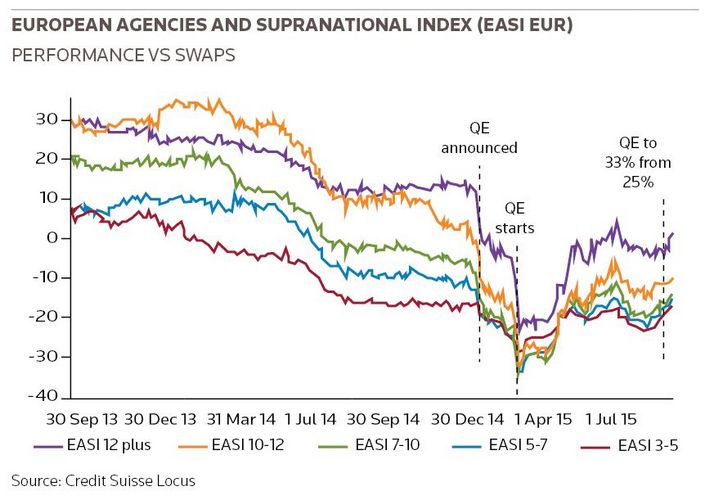The ECB’s long-awaited announcement in January that it would follow other central banks and commence its own quantitative easing programme caused yields on euro paper to nosedive. But like a thrill-seeker tied to a piece of elastic, the bounceback was equally dramatic
It was never the European Central Bank’s intention, when it announced its quantitative easing programme in January, to disrupt markets or skew issuance in any particular direction.
“That is why it didnt get involved in primary issuance in the SSA market and set a 25% limit on any one transaction – though that was later lifted to 33%,” said Greg Arkus, head of SSA DCM at Credit Suisse.
The ECB is careful to avoid leaving itself open to the accusation of being politically motivated, which direct participation in the primary market may have invited.
“That is in contrast to the ABS and covered bond markets, where it did participate in the primary market, the rationale being those markets had a more direct transmission mechanism into the real economy,” said Arkus.
Rather, the aim of ECB QE was managing sentiment and perception.
“It was about reversing the perception of tightening and managing the euro, which had strengthened significantly against the dollar and other currencies because Europe was not doing QE when others were,” said Arkus. “And it has been successful in that sense; the euro has weakened and that has been good for exporters, production and competitiveness.”
Yet measured against its desire to avoid market disruption, QE has been less successful. In the immediate aftermath of the announcement, yields for SSA bonds contracted significantly. Investors looking for carry went further out the curve as 10-year Bunds tightened from around 40bp–50bp in January to 5bp in April.
In March, the European Stability Mechanism (ESM) issued a €3bn October 2017 bond with minus 0.07% yield – the first euro benchmark deal with negative yield.
The initial collapse in spreads illustrated the fact that, with the ECB emerging as a massive buyer of bonds, and with a significant number of redemptions due in Q1, demand had completely swamped supply.
But QE was not the only cause of falling yields in Q1, said Lee Cumbes, head of SSAR origination for EMEA at Barclays.
“The market was generally concerned about disinflationary pressure, of which the low oil price was both a symptom and a cause. Moreover, the consensus mood was subdued with regard to global growth, despite some positive signs developing in Europe. Together, those are some of the factors that caused yields to fall. QE accelerated that move.”
With yields in the euro market at rock bottom, interest focused on the short end of the curve, for example ESM’s two-year deal in March. Longer dated issues such as Spain’s €3.5bn 1% November 2030 deal saw muted demand.
Demand also shifted to dollar-denominated paper. In one week in March, the European Investment Bank, Council of Europe, KfW and Caisse d’Amortissement de la Dette Sociale raised US$11bn between them through bonds with tenors of five years or below.
Bounceback
However, like a thrill-seeker reaching the end of the elastic on a bungee jump, euro spreads were quick to shoot back up. In May, 10-year Bunds hit 72bp, briefly touching 1% in June, again reflecting supply and demand dynamics. With supply outstripping demand in May, private investors had to be found to get deals done. The oil price also strengthened a little, reviving investor confidence in growth.
By September, 10-year Bunds were trading in a relatively narrow range of 60bp–80bp, close to where they were before QE had been announced. The same trend was illustrated by the Credit Suisse SSA index.
The drama was now in the US dollar market. China’s devaluation forced Asian central banks to sell dollars to defend their currencies, putting pressure on dollar yields and partly explaining the bounceback in euro supply – especially in longer dated paper. Bank Nederlandse Gemeenten issued a €1.75bn, seven-year deal in August, opting to issue in euros over dollars because it allowed the Dutch agency to achieve that longer tenor.
By September, longer dated deals were also getting much better reception. Belgium priced a €4bn June 2038 bond at 1.90% on the back of more than €7.5bn of demand. The EU followed that up with a €2bn issue of 20-year paper at 1.50%, attracting orders of €2.4bn, with the majority of demand coming from real money accounts.
Arkus said: “Recently, we have seen 20-year paper has been a bit of a sweet spot. We see demand for seven-year paper, but 10 and 15-year issues have been a bit more difficult. But at 20 years you hit investor yield targets and there is more interest.”
Market volatility had also made it difficult to do large deals for much of the year. When KFW priced its €5bn five-year in August, it took the market by surprise.
“There had not been a core credit SSA syndication of that size since January,” said Cumbes.
Dislocations persist
Yet it would be a stretch to say the market has normalised. For one thing, “we have seen an increase in the new issue premium attached to SSA paper”, said Kerr Finlayson, director of SSA debt syndicate at RBC.
“Historically, SSA primary issuance has traded 2bp–3bp back to the secondary market. but this year it has been as wide as 10bp, with recent euro supply suggesting it’s more like 6bp or 7bp.”
More significant has been the woes of the dollar market. One DCM banker said: “At the start of September we had Municipality Finance’s US$1bn three-year deal. But that is one significant-size dollar deal in a number of weeks. Usually in mid-September you might get around three to four deals of that size per week. So it is not simply a case of the dollar market being behind schedule. But neither is it a crisis.”
Yet it would be misleading to blame ECB QE for this. By September, its imact had arguably been completely drowned out by other factors. As Arkus said: “Concerns about China and the dovishness of the Fed will have far more impact on European spreads than ECB QE going forward.”
According to Finlayson,“the demand dynamic of QE needs to be addressed because demand for dollars is weakening. As the oil price has fallen, we have seen less demand from oil producing central banks. This, coupled with foreign exchange intervention is Asia, has seen a reduction in demand for dollar SSAs. Bank treasuries are becoming a bit more active given regulatory change but this only picks up part of the slack and will not continue indefinitely”.
Issues of US$1bn–$1.5bn should be no problem going forward, predicted Finlayson, but anything bigger may struggle without offering a significant new issue premium. “I can see issuers getting duration in the euro market and going to the dollar market with five-year trades.”
“There is better execution available in terms of volume and duration in the euro market – it has better momentum,” said Ulrik Ross, global head of public sector DCM at HSBC. “The cross-currency swap market obviously helps this; investors get a better pick-up in euros and can swap back into dollars. There is an expectation that the euro curve might flatten in coming months, which makes euro issuance at duration a good short-to-medium-term option.”
Overall, SSA issuance is around 40% down year on year compared to 2014, and this decline may be just the beginning. Deutsche Bank published a report in September arguing that “the great accumulation is over”, that FX reserves have peaked and the world is on the cusp of a new phase of quantitative tightening. It argues central banks are increasingly less inclined to manage their currencies, reducing the need for large FX reserves.
Deutsche analysts said: “The implications of our conclusions are profound. Central banks have accumulated US$10trn of assets since the start of the century, heavily concentrated in global fixed income. Less reserve accumulation should put secular upward pressure on both global fixed income yields and the US dollar. Many studies have found that reserve buying has reduced both Bund and US Treasury yields by more than 100bp.”
However, even if this assessment is true, the trend will take some time to play out. In the meantime, central banks remain important players in the market, and have influenced yields by selling dollars and buying other currencies, including euros.
One possibility is for the ECB to ramp up its QE. “I wouldn’t be surprised if the ECB decides to increase its purchases, but it is going to find it difficult to influence things. Once the Fed does hike rates, the ECB is going to be powerless,” said Arkus.
Issuers are braced for a period of uncertainty, said Ross, having become accustomed to increased volatility, bigger spikes and more shocks.
“That is the new reality and clients understand that. There is more headline risk, both politically and structurally, and we cant always guess what will happen. Issuers were comfortable going into the year, perhaps even too comfortable. There has been no sense of panic,” he said.
Issuers may opt to complete some pre-funding for next year, but that does not seem to be the prevailing strategy because there is no expectation of an impending crisis, added Ross.
Yet investors remain cautious. “Certain countries may have to intervene to stabilise their currencies. That intervention is being financed by the selling of government bonds. We believe this could exert upward pressure on bond yields,” said Tanguy Le Saout, head of European fixed income at Pioneer Investments.
“We have more conviction in our short Germany trade than in our short US trade, but the German position is really about market positioning, whereas the US position is more about central bank rate hikes. So, we don’t like either market, but we have more conviction that German yields will rise. Our short position in the US is at the front end of the yield curve, whereas in Germany the short position is in the 10-year area of the curve.”
To see the digital version of this report, please click here
To purchase printed copies or a PDF of this report, please email gloria.balbastro@thomsonreuters.com

